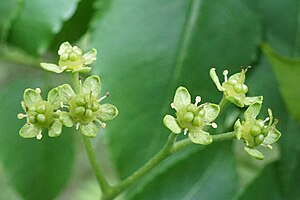Note: This is a project under development. The articles on this wiki are just being initiated and broadly incomplete. You can Help creating new pages.
Difference between revisions of "Picrasma quassioides"
| (One intermediate revision by the same user not shown) | |||
| Line 1: | Line 1: | ||
| − | [[File:Picrasma quassioides (India Quassiawood) (34797887960).jpg |thumb|right|'''Picrasma quassioides''']] | + | [[File:Picrasma quassioides (India Quassiawood) (34797887960).jpg|thumb|right|'''Picrasma quassioides''']] |
'''Picrasma quassioides''' is a species of Picrasma native to temperate regions of southern Asia, from the northeast of Pakistan east along the Himalaya and through southern, central and eastern China to Taiwan and Japan. | '''Picrasma quassioides''' is a species of Picrasma native to temperate regions of southern Asia, from the northeast of Pakistan east along the Himalaya and through southern, central and eastern China to Taiwan and Japan. | ||
==Uses== | ==Uses== | ||
| Line 8: | Line 8: | ||
==Chemical Composition== | ==Chemical Composition== | ||
| − | It contains trifolirhizin, maackiain, 3', 7-dihydroxy-4'-methoxylisoflavone, umbelliferone, emodin, nigakilactone F, picrasin B, picraqualide B, 4-methoxy-5-hydroxycanthin-6-one, 4,5-dimethoxycanthin-6-one, 5-methoxycanthin-6-one. | + | It contains trifolirhizin, maackiain, 3', 7-dihydroxy-4'-methoxylisoflavone, umbelliferone, emodin, nigakilactone F, picrasin B, picraqualide B, 4-methoxy-5-hydroxycanthin-6-one, 4,5-dimethoxycanthin-6-one, 5-methoxycanthin-6-one.<ref name="chemical composition"/> |
| − | <ref name="chemical composition"/> | ||
==Common names== | ==Common names== | ||
| Line 52: | Line 51: | ||
==How to plant/cultivate== | ==How to plant/cultivate== | ||
| − | Requires a fertile humus-rich moisture-retentive loam in a sunny position. Plants also succeed when growing in semi-shade. | + | Requires a fertile humus-rich moisture-retentive loam in a sunny position. Plants also succeed when growing in semi-shade.<ref name="How to plant/cultivate"/> |
| − | <ref name="How to plant/cultivate"/> | ||
==Commonly seen growing in areas== | ==Commonly seen growing in areas== | ||
| Line 77: | Line 75: | ||
==External Links== | ==External Links== | ||
| − | * [https://en.wikipedia.org/wiki/Picrasma_quassioides Picrasma quassioides] | + | * [https://en.wikipedia.org/wiki/Picrasma_quassioides Picrasma quassioides on wikipedia.org] |
[[Category:Herbs]] | [[Category:Herbs]] | ||
[[Category:Simaroubaceae]] | [[Category:Simaroubaceae]] | ||
Latest revision as of 11:01, 2 July 2020
Picrasma quassioides is a species of Picrasma native to temperate regions of southern Asia, from the northeast of Pakistan east along the Himalaya and through southern, central and eastern China to Taiwan and Japan.
Contents
- 1 Uses
- 2 Parts Used
- 3 Chemical Composition
- 4 Common names
- 5 Properties
- 6 Habit
- 7 Identification
- 8 List of Ayurvedic medicine in which the herb is used
- 9 Where to get the saplings
- 10 Mode of Propagation
- 11 How to plant/cultivate
- 12 Commonly seen growing in areas
- 13 Photo Gallery
- 14 References
- 15 External Links
Uses
Digestive problems, Chronic dyspepsia, Gastric.
Parts Used
Chemical Composition
It contains trifolirhizin, maackiain, 3', 7-dihydroxy-4'-methoxylisoflavone, umbelliferone, emodin, nigakilactone F, picrasin B, picraqualide B, 4-methoxy-5-hydroxycanthin-6-one, 4,5-dimethoxycanthin-6-one, 5-methoxycanthin-6-one.[1]
Common names
| Language | Common name |
|---|---|
| Kannada | |
| Hindi | |
| Malayalam | |
| Tamil | |
| Telugu | |
| Marathi | NA |
| Gujarathi | NA |
| Punjabi | NA |
| Kashmiri | NA |
| Sanskrit | |
| English | Nigaki |
Properties
Reference: Dravya - Substance, Rasa - Taste, Guna - Qualities, Veerya - Potency, Vipaka - Post-digesion effect, Karma - Pharmacological activity, Prabhava - Therepeutics.
Dravya
Rasa
Guna
Veerya
Vipaka
Karma
Prabhava
Habit
Identification
Leaf
| Kind | Shape | Feature |
|---|---|---|
| Simple | Coarsely and irregularly toothed margin | The leaves are 15–40 cm long, pinnate, with 7–15 leaflets 2.5–10 cm long and 1.5–4.5 cm broad. |
Flower
| Type | Size | Color and composition | Stamen | More information |
|---|---|---|---|---|
| Bisexual | Green to yellow-green | 8–15 cm long |
Fruit
| Type | Size | Mass | Appearance | Seeds | More information |
|---|---|---|---|---|---|
| Simple Fruit | Ovoid | 6–7 mm diameter | Red to black | {{{6}}} |
Other features
List of Ayurvedic medicine in which the herb is used
Where to get the saplings
Mode of Propagation
How to plant/cultivate
Requires a fertile humus-rich moisture-retentive loam in a sunny position. Plants also succeed when growing in semi-shade.[3]
Commonly seen growing in areas
Photo Gallery
References
External Links
- Ayurvedic Herbs known to be helpful to treat Digestive problems
- Ayurvedic Herbs known to be helpful to treat Chronic dyspepsia
- Ayurvedic Herbs known to be helpful to treat Gastric
- Herbs with Fruits used in medicine
- Herbs with Leaves used in medicine
- Herbs with Flower used in medicine
- Herbs with common name in English
- Habit - Tree
- Index of Plants which can be propagated by Seeds
- Herbs that are commonly seen in the region of Lowland forest
- Herbs
- Simaroubaceae




